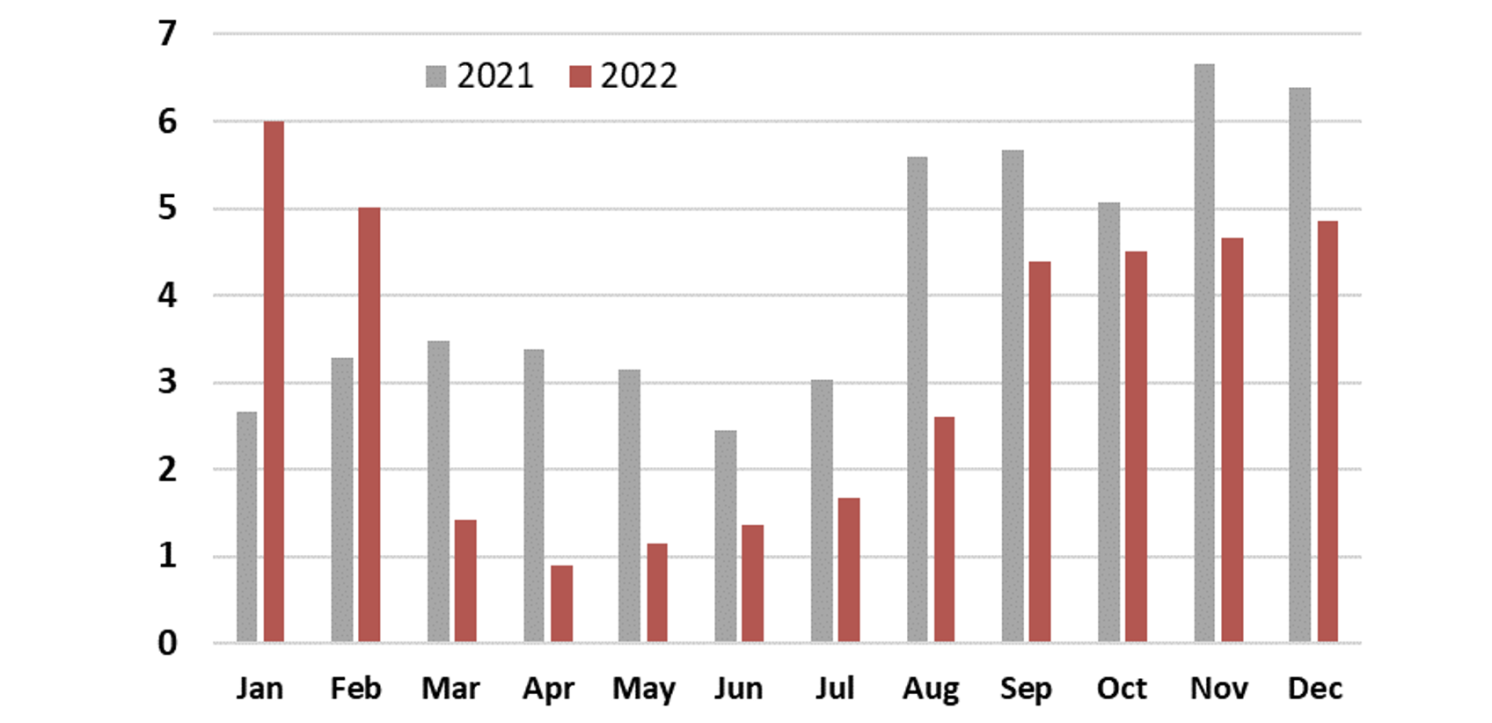As the war in Ukraine enters its second year, the need for increased global support becomes more apparent. This column illustrates this need with two examples: the damage to the economy caused by Russia’s attacks on the power grid and the stalled recovery of Ukraine’s grain exports due to Russia’s continued naval blockade. The economic difficulties that Ukraine’s population is facing due to the war have multiplied. Expanded and extended diplomatic and financial help will ease some of these difficulties.
In the face of the Ukraine’s resolute response to Russia’s invasion, President Putin has escalated the economic warfare against its citizens by incessantly attacking the country’s energy infrastructure and cutting off vital trade channels. These acts have severely hampered the prospects for economic recovery in 2023.
A large part of Ukraine’s civilian population, an estimated 6 million people, is awaiting the spring to return to their homeland, as the frequent power outages have forced them to keep temporary shelter in other European countries (Constantinescu 2022, Blinov and Djankov 2022a). These immigrants look forward to reuniting with their families and continuing with their jobs or finding new economic opportunity. In both cases, massive foreign help is needed to jumpstart the economy. The needs are enormous: rebuild infrastructure, provide financing for entrepreneurial activities as many old enterprises are razed to the ground, open new export opportunities, invest in training of workers and new technologies.
In this column, we gauge the economic losses from just two of the multiple ways in which the war has threatened the livelihoods of ordinary Ukraine citizens. We show that the near-daily aerial attacks on the country’s power grid and the frequent stalling in allowing ships to leave Ukrainian ports have hindered the economy to the tune of at least 15% of production, all else equal.
This analysis is in the spirit of previous work on estimating the cost of the war in Ukraine (e.g. Constantinescu 2022, Kappner et al. 2022, Artuc et al. 2022, the papers in the CEPR eBook edited by Rohner et al. 2022). As the aerial attacks on the power infrastructure continue at the time of this writing, as does the naval blockade, estimating their effect on economic prospects in Ukraine is an evolving task.
The effect of attacks on the power grid
To gauge the effect of power blackouts on the economy, we use daily data from ATMs operated by one of Ukraine’s biggest commercial banks. The bank has a wide network of around 500 ATMs covering all Ukrainian regions except for the temporarily occupied territories. When electricity is cut off from the ATM or from its data connection, this event is immediately recorded. Another recording takes place when power is restored, providing a good timing record of the lengths of blackouts in the respective geographical area. The analysis is extended to the month of December 2022 from our previous analysis in Blinov and Djankov (2022b).
We concentrate on the most business-intensive time period between 8am and 8pm. We then use power outage data for every ATM, calculated as a percentage of productive time without power. This measure at the ATM level is then averaged to a regional indicator and in turn we derive the national indicator from these regional measures, using as weights the pre-war shares of regions in Ukraine’s GDP.
Using this methodology, we calculate the monthly power loss (Figure 1). The national energy system had been resistant to attacks in September and October, localizing power outages to certain badly hit communities. However, Ukraine lost over 12% of its productive time in November, including a loss of over 23% of productive time during the last seven days of the month (after an air attack that caused a nation-wide blackout).
For the month of December, we have gauged the effect of alternative local power supply (electricity generators) installed in ATM-hosting property, as this way to provide stable electricity supply had become a widespread trend among banks and other businesses. We are hence able to assess both the absence of electricity and the amount of it compensated by emergency local power supply. Overall, Ukrainian businesses lost 15% of productive time because of power outages in December (more than in November, but less than in the final ‘black week’ of the previous month). Businesses managed to mitigate only 1 percentage point of this loss with installed emergency power supply, at significant cost of buying and installing these backup generators.
Figure 1 Length of power outages in October-December 2022 (% of productive time)


Source: Authors’ calculations based on commercial bank ATM data.
Stalled grain exports
Prior to the war, 89% of Ukraine’s grain exports were transported via Black Sea ports. The Ukrainian ports of Odesa, Chernomorsk, Pivdennyi and Mykolayiv were handling up to 6 million tonnes of grain per month in 2021 and were preparing to set new records in 2022 thanks to investment in expanded port infrastructure and bountiful crops.
Even before the start of the Russian invasion, the sea routes had been partially blocked by Russian military naval training. When the war started, full naval blockade was instituted upon Ukrainian ports and two of them – Berdyansk and Mariupol – were occupied by Russian troops. Ukrainian exporters have had to improvise with grain handling there, an intermediary step to the Romanian port of Constanța. Overall, Izmail and Reni handled around 45% of total grain exports in May. As a result, the financial losses to agricultural exporters are estimated at $200 million a day in March through May 2022 (Blinov and Djankov 2022c).
Railways and trucks have started being used to haul grain into EU countries, increasing transit costs dramatically and still not being to fill the gap of blockaded ports. In May 2022, for example, only 40,000 tonnes of grains (4% of the total) were exported by trucks. The remaining exports (around half of the total quantity) were transported by train through Poland, Slovakia and Hungary. With all this effort, Ukraine managed to export only around 1 million tonnes per month in April and May.
Figure 2 Monthly grain exports from Ukraine in 2021-2022 (million tonnes)


Source: State Customs Service of Ukraine.
Partial reopening of Ukraine’s seaports (Odesa, Chernomorsk, Pivdennyi) in August after a brokered agreement with Russia has allowed to expand monthly grain exports to over 4 mln tonnes. However, frequent stalling by Russia in allowing ships through the blockade, elevated insurance and freight prices, and recent threats to halt the grain corridor altogether have meant that November and December exports have again fallen down relative to the 2021 export volumes (Figure 2). This trend is worrying, and grain exports suffered a further setback in January 2023 when Russia instituted ship security checks.
All help, all now
In this column, we illustrate with just two examples the huge economic damage that Russia’s invasion has dealt to ordinary Ukrainian citizens. This is on top of the daily cost of war and tremendous loss of live and livelihood.
And all-out aggression requires an all-out response. Such response is necessary in financial terms as well. For Ukrainians both at home and in temporary refugee status, it is important to see prospects of normal economic life. The sums of foreign aid to ensure such normality are staggering and will no doubt be made over the years to come. Better start now, without hesitation.
Source : VOXEu





